Age and Ketogenic Diet Have Dissociable Effects on Synapse-Related Gene Expression Between Hippocampal Subregions
- PMID: 31607897
- PMCID: PMC6755342
- DOI: 10.3389/fnagi.2019.00239
Age and Ketogenic Diet Have Dissociable Effects on Synapse-Related Gene Expression Between Hippocampal Subregions
Abstract
As the number of individuals living beyond the age of 65 is rapidly increasing, so is the need to develop strategies to combat the age-related cognitive decline that may threaten independent living. Although the link between altered neuronal signaling and age-related cognitive impairments is not completely understood, it is evident that declining cognitive abilities are at least partially due to synaptic dysfunction. Aging is accompanied by well-documented changes in both excitatory and inhibitory synaptic signaling across species. Age-related synaptic alterations are not uniform across the brain, however, with different regions showing unique patterns of vulnerability in advanced age. In the hippocampus, increased activity within the CA3 subregion has been observed across species, and this can be reversed with anti-epileptic medication. In contrast to CA3, the dentate gyrus shows reduced activity with age and declining metabolic activity. Ketogenic diets have been shown to decrease seizure incidence and severity in epilepsy, improve metabolic function in diabetes type II, and improve cognitive function in aged rats. This link between neuronal activity and metabolism suggests that metabolic interventions may be able to ameliorate synaptic signaling deficits accompanying advanced age. We therefore investigated the ability of a dietary regimen capable of inducing nutritional ketosis and improving cognition to alter synapse-related gene expression across the dentate gyrus, CA3 and CA1 subregions of the hippocampus. Following 12 weeks of a ketogenic or calorie-matched standard diet, RTq-PCR was used to quantify expression levels of excitatory and inhibitory synaptic signaling genes within CA1, CA3 and dentate gyrus. While there were no age or diet-related changes in CA1 gene expression, expression levels were significantly altered within CA3 by age and within the dentate gyrus by diet for several genes involved in presynaptic glutamate regulation and postsynaptic excitation and plasticity. These data demonstrate subregion-specific alterations in synaptic signaling with age and the potential for a ketogenic diet to alter these processes in dissociable ways across different brain structures that are uniquely vulnerable in older animals.
Keywords: CA1; CA3; GABA; ROCK; dentate gyrus; glutamate; metabolism.
Copyright © 2019 Hernandez, Hernandez, Truckenbrod, Campos, McQuail, Bizon and Burke.
Figures


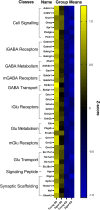
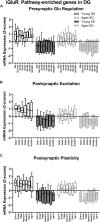
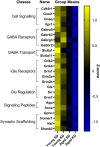
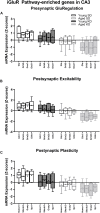

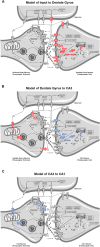
Similar articles
-
Developmental regulation and cell-specific expression of N-methyl-D-aspartate receptor splice variants in rat hippocampus.Neuroscience. 1997 Jul;79(2):399-409. doi: 10.1016/s0306-4522(96)00677-x. Neuroscience. 1997. PMID: 9200724
-
Differential effects of levetiracetam on hippocampal CA1 synaptic plasticity and molecular changes in the dentate gyrus in epileptic rats.Neurochem Int. 2022 Sep;158:105378. doi: 10.1016/j.neuint.2022.105378. Epub 2022 Jun 24. Neurochem Int. 2022. PMID: 35753511
-
Preictal activity of subicular, CA1, and dentate gyrus principal neurons in the dorsal hippocampus before spontaneous seizures in a rat model of temporal lobe epilepsy.J Neurosci. 2014 Dec 10;34(50):16671-87. doi: 10.1523/JNEUROSCI.0584-14.2014. J Neurosci. 2014. PMID: 25505320 Free PMC article.
-
Epileptogenesis in the dentate gyrus: a critical perspective.Prog Brain Res. 2007;163:755-73. doi: 10.1016/S0079-6123(07)63041-6. Prog Brain Res. 2007. PMID: 17765749 Review.
-
Glutamate dysfunction in hippocampus: relevance of dentate gyrus and CA3 signaling.Schizophr Bull. 2012 Sep;38(5):927-35. doi: 10.1093/schbul/sbs062. Epub 2012 Apr 24. Schizophr Bull. 2012. PMID: 22532703 Free PMC article. Review.
Cited by
-
The ketogenic diet has the potential to decrease all-cause mortality without a concomitant increase in cardiovascular-related mortality.Sci Rep. 2024 Oct 1;14(1):22805. doi: 10.1038/s41598-024-73384-x. Sci Rep. 2024. PMID: 39353986 Free PMC article.
-
Touchscreen-Based Cognitive Training Alters Functional Connectivity Patterns in Aged But Not Young Male Rats.eNeuro. 2023 Feb 24;10(2):ENEURO.0329-22.2023. doi: 10.1523/ENEURO.0329-22.2023. Print 2023 Feb. eNeuro. 2023. PMID: 36754628 Free PMC article.
-
Age-Related Alterations in Prelimbic Cortical Neuron Arc Expression Vary by Behavioral State and Cortical Layer.Front Aging Neurosci. 2020 Oct 28;12:588297. doi: 10.3389/fnagi.2020.588297. eCollection 2020. Front Aging Neurosci. 2020. PMID: 33192482 Free PMC article.
-
Time restricted feeding with or without ketosis influences metabolism-related gene expression in a tissue-specific manner in aged rats.Geroscience. 2025 Jun;47(3):4845-4855. doi: 10.1007/s11357-025-01632-7. Epub 2025 Mar 28. Geroscience. 2025. PMID: 40153191 Free PMC article.
-
Feeding the Brain: Effect of Nutrients on Cognition, Synaptic Function, and AMPA Receptors.Nutrients. 2022 Oct 5;14(19):4137. doi: 10.3390/nu14194137. Nutrients. 2022. PMID: 36235789 Free PMC article. Review.
References
Associated data
Grants and funding
LinkOut - more resources
Full Text Sources
Research Materials
Miscellaneous

